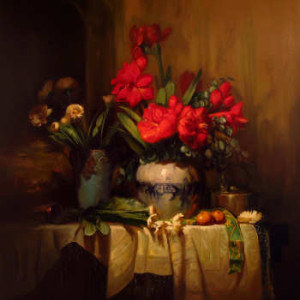
40×40 inches, Oil on Linen
© Margret E. Short, OPA, AWAM
I read about PRONK in Still Lifes: Techniques and Style , and it really didn’t give any specific meaning of the word. It actually was used as a description for a certain style of painting. It was not in the book’s glossary or index. After searching six or seven other still life and painting technique books, I was still at a loss. Wikipedia and all the other on-line dictionary sites yielded nothing also. My huge Reader's Digest Great Encyclopedia Dictionary includes an English to Dutch section, but this was also a dead-end.
Over the past couple of weeks, I have been in contact with the Rijksmuseum working out some technical aspects of my project. I suddenly thought, "why not go right to the source?" I immediately sent off an email to the Registrar's Office and received an response right away.
The description of pronk from the Rijksmuseum states, "pronk stilleven or pronk schilderij which means something like showpiece still-life, an extraordinary piece with an image extremely difficult to paint. Silver, grapes covered with dew, lemons, glassware and so on."
It made perfect sense. If you will picture in your mind's eye, the sumptuous still lifes depicting tables laid with crisp white linen filled with stemware, compotes, lobsters, and flowers. Many have silver, brass, gold, platters, fruit, brocades, tassels, and just about anything you can think of that might be in a Dutch household. This is PRONK.
The image posted here is a painting I did last year. It is not one of the Lessons from the Low Countries pieces, but is an example of the PRONK style of painting. Amaryllis measures 40×40 and has some of the same components which would qualify.
There are several sumptuous still lifes in the Rembrandt and the Golden Age of Dutch Art Exhibition. Paintings by Pieter Claesz, Jan Jansz van de Velde, and Abraham Mignon are all good examples.
If any readers of this blog have any more information about PRONK please post a comment.

Once again, you are referencing one of the best ever books, Still Lifes: Techniques and Style. To my English speaking ear, PRONK also had an amusing sound to me so I had asked my German speaking wife if she thought there was a German word equivalent. She suggested ‘Prunk’ which means splendor, or showy, even ostentatious, citing an Aunt who loved to show off her silver and leaded glass and another Aunt who was Prunklos,proud of her whole grain bread and butter. The great masters never failed to temper their pronk with the plain, underscoring their Vanitas themes. sander
What a great word to learn! Now, I just have to find occasion to use it.
All artists should be aware of PRONK
In Margret Short’s research of still-life painting, she came upon the Dutch word PRONK. Although sounding far too much like prank or honk to be music to my ear, the word has a special meaning that might come in handy. Does it apply to your work? (Read …
I’m not a still life painter but I love learning wonderful, new words.
The colors in this painting are just gorgeous.
The word “Pronk” is still known in the Dutch language, although perhaps not used on a daily basis. The first image that comes to my mind as a native speaker is a peacock displaying his feathers. He “pronkt” with his feathers.
The second thing I think about is the word “pronkkamer”. That used to be the room with the best furniture, paintings, curtains. It was not to be used other than on special occasions. A painting of a stilleven would be an excellent “pronkstuk” for the room.
When specifically used for a painting it would indicate that the work is a piece made to display the very best a painter was capable of, to my mind with the emphasis on especially the technical abilities.
Thank you for sharing this with us – I to need an occasion to use this word. Your painting certainly reminds me of the old masters with subject matter and lighting.
~ Diane Clancy
As an alpaca breeder I have to comment on the word “pronk”. It is used in the alpaca world to describe the way an alpaca will run and play by jumping in the air. It is a delight and joy to be hold!
Thank you for the information.
It gives new meaning to both my art videos and blog.
I consider both to be showcases for my videos and writing.
I have posted several videos on YouTube about artists including Vermeer:
http://www.youtube.com/user/raymondpronk
I also have a blog called Pronk Palisades:
http://raymondpronk.wordpress.com/
Thanks again.
“Pronken” in Dutch, means showing off. I’ve always been thought that a “Pronk Still life painting” was meant to show and prove the owners or commissioners wealth. That’s why tulips (very expensive at the time), silverware, glass, etc. are often on display in these still life paintings. Also “Vanitas” symbols are often incorporated in these works as a counterweight (despite my vanity, I know I’m mortal).
I love the painting with this post. Beautiful blog!
Thanks
This really is an wonderful written write-up, Thanks for yet a different insightful post, as consistently!